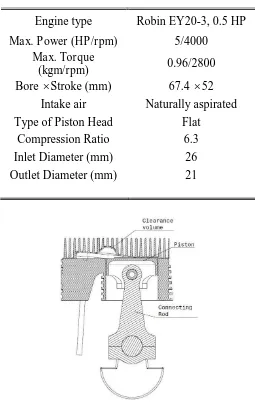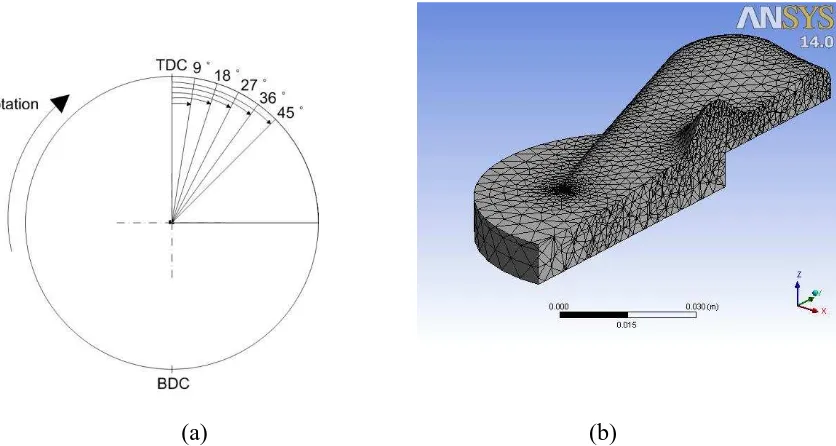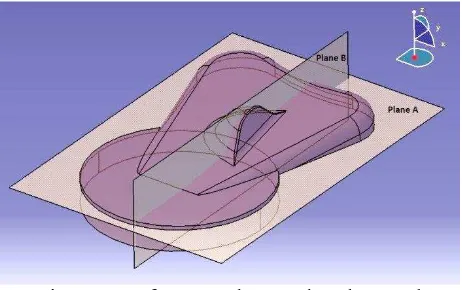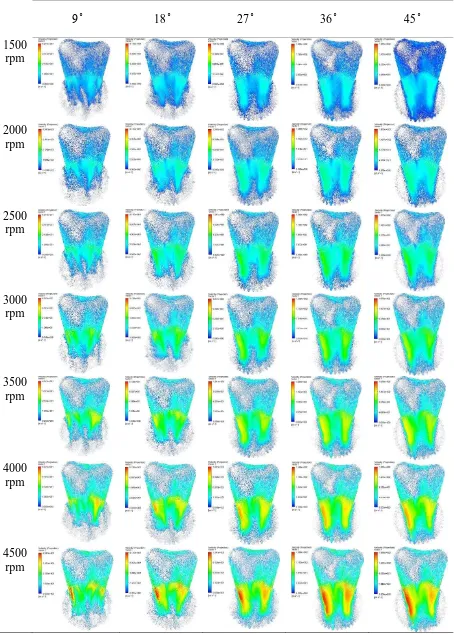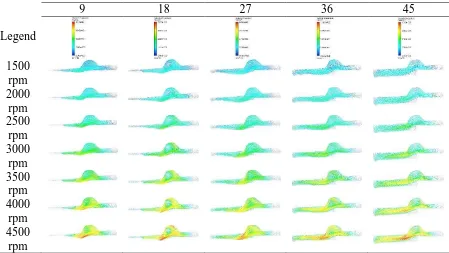INTAKE ANALYSIS ON FOUR-STROKE ENGINE USING CFD A. M. Mohd Shafie1, a, Musthafah M. T.1, b, M. S. Ali1, c, Rosli A. Bakar2, d
1
Faculty of Mechanical Engineering, Universiti Teknikal Malaysia Melaka, Hang Tuah Jaya,
76100 Durian Tunggal Melaka, Malaysia
*
Email: [email protected]
2
Faculty of Mechanical Engineering, Universiti Malaysia Pahang, 26600 Pekan, Pahang, Malaysia
a
[email protected], [email protected], [email protected],
d
ABSTRACT
Flow pattern is vital to ensure that the engine can produce high performance with the presence of swirl and tumble inside the cylinder. In this paper, the simulation of air is simulated in the software to predict the flow pattern using the steady state pressure based solver at two different planes in the engine domain. The domain used for the simulation is based on the actual engine parameters. Using the commercial CFD solver ANSYS FLUENT, the CFD simulation is run under five different piston positions and seven different engine speeds. Note that in this simulation, only intake strokes are simulated. The results show the velocity of the flow is high during the sweep as the intake stroke takes place. This situation is believed to produce more swirl and tumble during the compression hence enhancing the burning rate in entire region of the clearance volume.
Keywords: CFD; fluent; in-cylinder flow; intake flow; Meshing.
INTRODUCTION
Engine is used to propel the vehicle by converting the chemical energy to mechanical motion. Reciprocating Engine with four-stroke cycle consists of intake stroke, compression stroke, expansion stroke and exhaust stroke. At the stages of intake and compression stroke, it is the most influential part to dictate the flow pattern and structure of air entering and exiting the swept volume. Air flow for the internal combustion engine is generally in turbulent flow as the speed of the internal combustion engines is high (panday and bidesh, 2012). This turbulent flow is excluded when the flow goes through crevices volume as it will diminish the turbulence near the wall. Domain used in the simulation is based on the engine used by Ammar et al. (2014) for engine dynometer with 3.36 kW of power. Typically, turbulence kinetic energy and turbulence kinematic viscosity are the benchmark to measure the turbulence with compressible flow in the cylinder (Pandey and Bidesh, 2012).
2
turbulence models such k-epsilon and RNG in the CFD. Stefano et al. (2013) stated that instead of using the simple model, it is recommended to use more refined model such as Large Eddy Simulation (LES) or Detached Eddy Simulation (DES). On the other hand, for a better RANS modelling, it is recommended to use Reynolds Stress and K-omega SST with enough resolution for near wall flow. Stefano et al. (2013) stated that in recent years, the Large Eddy Simulation (LES) or Detached Eddy Simulation (DES) were used in application of flows in the internal combustion engine. Flow in the cylinder of the engine inherently decisive for the combustion performance of the engine (Hemant and Saurish, 2013).
During the intake stroke and compression stroke, creating a vortical flow motion which is swirl and/or tumble is indispensable not only to have a fast burning rate but also high mixing process with the air inside the engine cylinder. It is due to single properly defined vortical structure is more stable than other large scale in-cylinder flow (Bari and Idris, 2013; Panday and Bidesh 2012). Swirl is air movement in the cylinder about the cylinder axis while tumble is a movement of air in direction of upside to downside or conversely that circles at perpendicular axis to the engine cylinder. Hence, during combustion it generates higher turbulence and faster flame-front propagation (Hemat and Saurish, 2013). Besides, suitable value of swirl will improve the fuel efficiency hence the duration of the combustion can be abbreviated. Panday and Bidesh (2012) claimed that 4% from burning time loss is one of the primary lose in spark ignition engine which its occurrence resulting from finite time of combustion. Increasing the degree of swirl leads to increase of the turbulence intensity inside the cylinder and this situation can eliminate the loss from burning time. Higher turbulence intensity produces more stable ignition process and faster flame propagation particularly in lean-burn combustion.
SIMULATION SETUP Computational Domain
3
Table 1. Specification of engine used.
Engine type Robin EY20-3, 0.5 HP
Max. Power (HP/rpm) 5/4000
Max. Torque
(kgm/rpm) 0.96/2800
Bore Stroke (mm) 67.4 52 Intake air Naturally aspirated
Type of Piston Head Flat
Compression Ratio 6.3
Inlet Diameter (mm) 26
Outlet Diameter (mm) 21
Figure 1: Clearance volume of the in-cylinder engine
4
Figure 3(a) shows the complete cycle of a four-stroke engine. The position of the engine are varied with 9°, 18°, 27°, 36°, and 45° after top dead center. Furthermore, the simulation is run at various speed with increment of 500 rpm starting at 1500 rpm and ending at 4500 rpm. Note that the shape of the cylinder head is flat in shape.
The mesh quality needs to comply with mesh metric of maximum skewness below 0.98 and the maximum orthogonal quality with approach to one. Mesh skewness is vital to control because it will affect not only the convergence but also the result of the simulation. The domain shown in Figure 3(b) illustrated the cut-view with the piston located 45° after top dead center and it was in a good quality of mesh with maximum skewness of 0.968 and orthogonality of 0.996. The elements for the domain are 148852 of tetrahedron element.
(a) (b)
Figure 3. (a) Complete cycle; (b) Cut-view of the clearance volume of engine
Numerical Strategy
The compressible Navier-Stoke equations of momentum, continuity and energy were used to solve the flow simulation in ANSYS FLUENT. The generalization for each of governing equations have the following forms, respectively:
Mass equation
5 is the density of fluid used in the simulation.
Momentum equation
Momentum equation is founded from the Newton’s second law of fluid motion which the body and the surface forces considered in the control volume are described as:
U U
p SM momentum sources acting on the fluid. These equations are also known as the Navier-Stoke equation. order to solve the simulation of the domain.Simulation Setting
This simulation is performed in the steady state with pressure-based solver that solves the equation of energy, momentum and continuity at initial. Model of k-epsilon of realizable with Non-equilibrium wall function is used since the model is simple and stable for the initial simulation strategy to predict the flow pattern in the cylinder (Stefano et al, 2013). The purpose of using Non-equilibrium wall function is to indicate the flow near the wall as the source of the turbulence and vorticity (Kumar et al, 2013).
6
is at 1500 rpm, 2000 rpm, 2500 rpm, 3000 rpm, 3500 rpm, 4000 rpm and 4500 rpm. However, the initial gauge pressure is set as 1 atm for all engine speed. The pressure outlet is set to 0.87 Pa as referred to the GT-Power software as the pressure is low when the intake process occurs.
RESULTS AND DISCUSSION
All of the results for the simulation are illustrated based on the planes as shown in the Figure 4 consist of Plane A and Plane B to ensure the comparison is at the similar place. Plane A is illustrated as a cutaway view in the clearance volume viewed from the z-direction with the same axis as the cylinder axial axis. Meanwhile Plane B is a cutaway viewed from x-direction. Plane A located at the bottom surface of the combustion chamber in order to monitor the velocity profile when air enters the cylinder. Plane B is placed near to the flow entering the spark plug region.
Figure 4. reference plane to be observed
7
18 27 36 45
1500 rpm
2000 rpm
2500 rpm
3000 rpm
3500 rpm
4000 rpm
4500 rpm
8
Figure 6 shows the view of the air flow at the Plane B located vertically with the cylinder and near the spark plug location. At this position, the flow of air produces around the spark plug can be observed. Most of the flows at this view have higher velocity at the entrance to swept volume which is cylindrical as viewed from the Plane A. From Figure 6, it shows that at the engine speed at 4500 rpm with piston located 18 degree after top dead center develops high velocity near ignition region. This can be one of the triggers of producing a tumble at the combustion chamber. Among of all boundary condition given, engine speed of 4500 rpm and crank angle of 45 degree creates highest velocity at the entrance of swept volume which is then believed to produce swirl and tumble. Hence, enhanced mixing of the fuel and air improves the engine performance. High engine speed produces high inlet air flow which helps the development of higher swirl and vice versa.
9 18 27 36 45
Figure 6. Flow Viewed from Plane B
CONCLUSION
9
will be performed with the presence of fuel and air to observe the mixing process occurs in the clearance volume and swept volume.
ACKNOWLEDGEMENTS
The authors are grateful to Faculty of Mechanical Engineering, Universiti Teknikal Malaysia Melaka (UTeM) for financial support in short-term grant research project no. PJP/2013/FKM(9B)/SC01227. The deepest appreciation is granted to the research center of Faculty of Mechanical Engineering (GTeV, CARe) as well as Universiti Malaysia Pahang, Professor Dato’ Rosli Abu Bakar for the assistance in this project.
REFERENCES
S. Bari & Idris Saad (2013). CFD modelling of the effect of guide vane swirl and tumble device to generate better in-cylinder air flow in a CI engine fuelled by biodiesel. Computers & Fluid, 84, 262-269
Hemant Punekar & Saurish Das (2013). Numerical simulation of subcooled nucleate boiling in cooling jacket of IC engine. SAE Technical Paper. 2013-01-1651
R. F. Huamg, H. S. Yang & C. –N. Yeh (2008) In-cylinder flows of a motored four-stroke engine with flat-crown and slightly concave-crown piston. Experiment Thermal and fluid science. 32, 1156-1167
Vinodh Kumar B., Sivagaminathan N., Gopalakrishnan N., Scott Morton & Paul Radavich (2010). Air flow and charge motion study of engine intake port. Proceedings of the 37th National & 4th International Conference on Fluid Mechanics and Fluid Power, FMFP10-CR-10
Stefano Fontanesi, Giuseppe Cicalese & Elena Severi (2013) Analysis of turbulence model effect on the characterization of the in-cylinder flow field in a HSDI diesel engine. SAE technical paper. 2013-01-1107
Ammar Alfaiz M. A., Musthafah M. Tahir, Rosli A. Bakar, M. Shahir Ali, Abdul Muhaimin (2013) New design of a low cost small engine dynometer of engine testing. 3rd International Conference and Exhibition on Sustainable Energy and Advanced Material,
Our ref : UMP.14.04/20.11/1/AL (P138) Date : 2 6 M a y 2 0 1 4
Paper ID: P138
Paper Title: INTAKE ANALYSIS ON FOUR-STROKE ENGINE USING CFD
Authors Name: A. M. Mohd Shafie, Musthafah M. T., M. S. Ali, Rosli A. Bakar
Dear Author,
Sub: Acceptance of Paper for AiGEV 2014, Kuantan, Pahang, Malaysia.
CONGRATULATIONS!
We are pleased to inform you that your paper entitled above has been reviewed and accepted for presentation at the AiGEV 2014 which will be held from 26 – 27 August 2014 at Swiss Garden Resort & Spa, Kuantan, Pahang, Malaysia.
For your information, your paper will be published in the Applied Mechanics and Materials Proceeding Journal (Trans Tech Publications) which indexed by Scopus, subject to receipt of the registration fee of the AiGEV 2014 conference. Selected papers will be published in IJAME (Scopus Indexed Journal) or JMES (UMP Journal) . The presentation will be in the form of oral presentation. It is expected that at least one of the authors will attend the conference and present the paper. Please refer to our official website http://aigev.ump.edu.my or email to [email protected] for any inquiry, details and updates.
Best wishes and looking forward to your participation in Kuantan, Pahang, Malaysia.
Thank you,
Yours sincerely,
DR. ADAM BIN ABDULLAH
Chairman,
International Conference on Automotive Innovation and Green Energy Vehicle (AiGEV 2014), Automotive Engineering Centre (AEC),
Universiti Malaysia Pahang, 26600 Pekan,
PAYMENT INFORMATION
